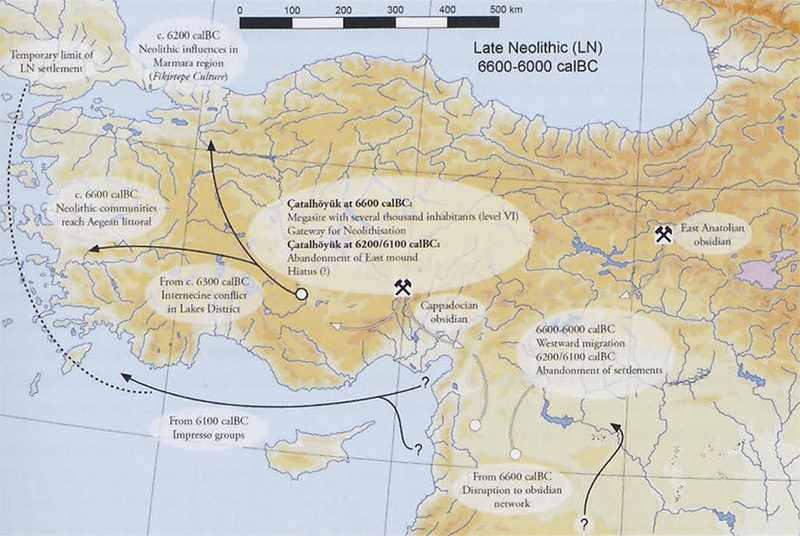New paper (behind paywall) Agricultural origins on the Anatolian plateau, by Baird et al. PNAS (2018), published ahead of print (March 19).
Abstract (emphasis mine):
This paper explores the explanations for, and consequences of, the early appearance of food production outside the Fertile Crescent of Southwest Asia, where it originated in the 10th/9th millennia cal BC. We present evidence that cultivation appeared in Central Anatolia through adoption by indigenous foragers in the mid ninth millennium cal BC, but also demonstrate that uptake was not uniform, and that some communities chose to actively disregard cultivation. Adoption of cultivation was accompanied by experimentation with sheep/goat herding in a system of low-level food production that was integrated into foraging practices rather than used to replace them. Furthermore, rather than being a short-lived transitional state, low-level food production formed part of a subsistence strategy that lasted for several centuries, although its adoption had significant long-term social consequences for the adopting community at Boncuklu. Material continuities suggest that Boncuklu’s community was ancestral to that seen at the much larger settlement of Çatalhöyük East from 7100 cal BC, by which time a modest involvement with food production had been transformed into a major commitment to mixed farming, allowing the sustenance of a very large sedentary community. This evidence from Central Anatolia illustrates that polarized positions explaining the early spread of farming, opposing indigenous adoption to farmer colonization, are unsuited to understanding local sequences of subsistence and related social change. We go beyond identifying the mechanisms for the spread of farming by investigating the shorter- and longer-term implications of rejecting or adopting farming practices.

Interesting excerpts:
The persistence of foraging and rejection of farming at Pınarbaşı is also worthy of further consideration. Pınarbaşı’s longevity as a settlement locale in the early Holocene appears to have been based on hunting of wild mammals, wetland exploitation, and significant focus on nut exploitation, all afforded by its ecotonal setting between the hills, plain, and wetland. Perhaps this existing diversity, including nutritious storable plant resources, was a key factor in a lack of interest in adopting cultivation. Another factor may have been a conscious desire to maintain traditional identities and long-standing distinctions with other communities, in part reflected in its particular way of life and its specific connections with particular elements in landscape, for example the almond and terebinth woodlands whose harvests underwrote the continuity of the Pınarbaşı settlement.
The variability in response to the possibilities of early food production in a relatively small geographical area demonstrated here is notable and provides an example useful in evaluating the spread of farming in other regions. It shows the possible role of indigenous foragers, the potential patchwork and diffuse nature of the spread of farming, the lack of homogeneity likely in the communities caught up in the process, the probability of significant continuities in local cultural traditions within the process, and the potentially long-term stable adaptation offered by lowlevel food production. The strength of identities linked to exploitation of particular foods and particular parts of the landscape may have been a major factor contributing to rejection or adoption of food production by indigenous foragers.
The results are also relevant for understanding the processes that underpinned the initial development of farming within the Fertile Crescent itself: that is, the region in which the wild progenitors of the Old World founder crops and stock animals are found. Recent research has rejected the notion of a core area for farming’s first appearance in southwest Asia and demonstrated that farming developed in diverse ways over the Fertile Crescent zone from the southern Levant to the Zagros, very analogous to the situation just described for Central Anatolia (2). Cultivation, herding, and domestication developed in that region, and it seems inescapable that exchange of crops and herded animals occurred between communities (2), involving a spread of farming within the Fertile Crescent, leading eventually to the Neolithic farming package that was so similar across the region and which spread into Europe (5). Central Anatolia was clearly linked to the Fertile Crescent, with significant evidence of exchange and some shared cultural traditions from at least the Epipaleolithic (22). The evidence presented here demonstrates very clearly the movement of crops between settlements and regions in early phases of the Neolithic through exchange, and thus allows us to identify episodes of crop exchange that were probably taking place within the Fertile Crescent itself, but are difficult, if not impossible, to distinguish due to the presence of crop progenitors across much of the region.
A very interesting read in combination with 14C-radiometric data and climatic conditions showing potential triggers of dispersal of Neolithic lifeways from Turkey to Southeast Europe, e.g. Dispersal of Neolithic Lifeways: Absolute Chronology and Rapid Climate Change in Central and West Anatolia, by Lee Clare & Bernhard Weninger, in The Neolithic in Turkey, Vol.6 (2014), Edited by Mehmet Özdogan, Nezih Basgelen, Peter Kuniholm.

Featured image, from the latter: “In the Early Pottery Neolithic (7000-6600 cal. BC) there occurs a clear break with precedeing (PPN) traditions, attested by abandonment and decreasing size of settlements, albeit that evidence for migration of groups westwards towards the Aegean is still ambiguous (black arrows: human migrations; white arrows: Anatolian obsidian)”
See also:
- Differing modes of animal exploitation in North Pontic Eneolithic and Bronze Age Societies
- Corded Ware pastoral herding economy and belief system through mortuary practices
- Corded Ware culture contacts in the Baltic Sea region linked to immigrant potters
- Recent archaeological finds near Indo-European and Uralic homelands